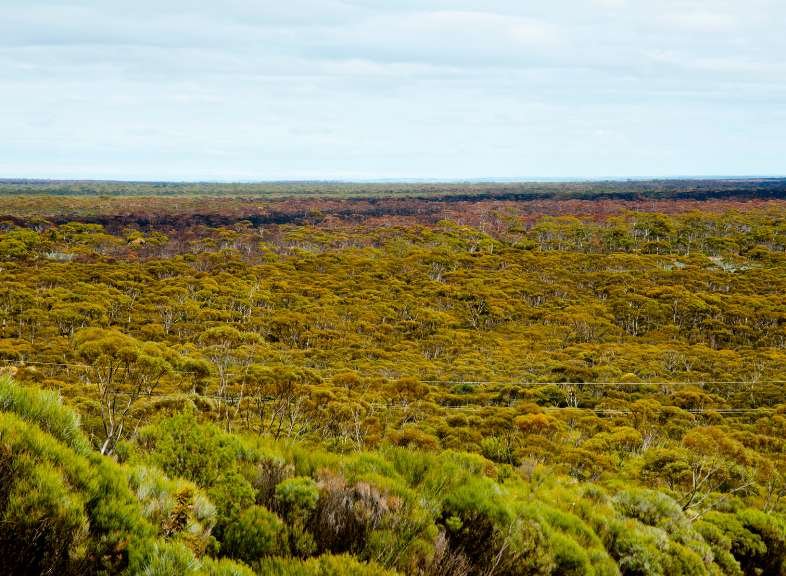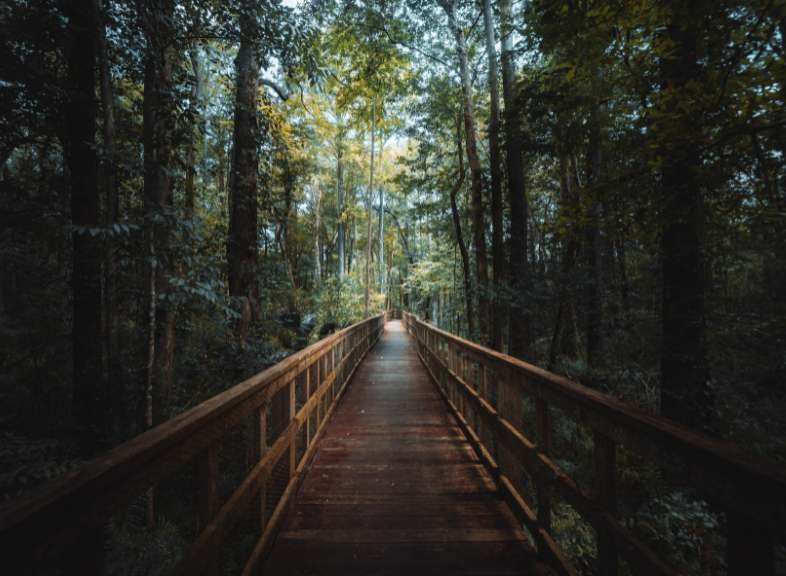Most Epic Long Distance Trails in the USA
Are you a hiking enthusiast who dreams of exploring the country’s most scenic and challenging trails? Do you crave adventure, solitude, and nature’s beauty in equal measure? If so, you might want to look beyond the Appalachian Trail, the most famous and popular long-distance trail in the USA.
While the Appalachian Trail is undoubtedly a remarkable feat of hiking, it is not the only one. Many other trails offer equally stunning landscapes, diverse ecosystems, and rich history.
Some of them are even longer, harder, and wilder than the Appalachian Trail. In this blog post, we will introduce you to 10 epic long-distance trails in the USA that will give you goosebumps and inspire you to lace up your boots and hit the trail.
People Also Read: Discover the 22 Most Beautiful & Best Hikes in the US (Intermediate to Short)
Great Western Loop: 6,875 miles

The Great Western Loop is a massive loop that connects five existing long-distance trails: the Pacific Crest Trail, the Pacific Northwest Trail, the Continental Divide Trail, the Grand Enchantment Trail, and the Arizona Trail.
It passes through 12 national parks and over 75 wilderness areas, showcasing the best of the American West. From the deserts of Arizona to the glaciers of Montana, from the volcanoes of Washington to the canyons of Utah, this trail will take you on a journey through some of the most diverse and spectacular terrain in the world.
The Great Western Loop was first completed by Andrew Skurka in 2007, who hiked an average of 33 miles per day for 208 days. Since then, only a handful of hikers have followed his footsteps.
American Discovery Trail: 6,800 miles

The American Discovery Trail is a coast-to-coast trail that spans from Delaware to California, crossing 15 states and Washington, D.C. It is unique among long-distance trails in that it combines urban and rural areas, allowing hikers to experience the country’s cultural and natural heritage.
The trail passes through many historical sites, such as Independence Hall, Mount Vernon, and Golden Gate Bridge, as well as scenic wonders, such as the Appalachian Mountains, the Rocky Mountains, and the Sierra Nevada.
The trail also connects with several other national scenic trails, such as the Appalachian Trail, the North Country Trail, and the Pacific Crest Trail. The American Discovery Trail was established in 1989 by a group of hiking enthusiasts who wanted to create a trail that would link people and places across America.
Eastern Continental Trail: 5,400 miles

The Eastern Continental Trail is a hiking route that stretches from Key West in Florida to Cape Gaspe in Quebec, Canada. It follows a combination of existing trails and roads along the eastern seaboard of North America.
Some of the trails that make up the Eastern Continental Trail are the Florida Trail, the Appalachian Trail, the International Appalachian Trail, and the Sentier International des Appalaches. The route traverses a variety of landscapes and climates, from tropical islands to boreal forests, from swamps to mountains.
The Eastern Continental Trail was first hiked by John Brinda in 1997, who coined the name of the route. It was later popularized by M.J. “Nimblewill Nomad” Eberhart in his book Ten Million Steps, which chronicled his journey along the trail.
North Country Trail: 4,600 miles

The North Country Trail is one of America’s 11 National Scenic Trails. It runs from North Dakota to Vermont, following the northern tier of states along or near the Canadian border. It passes through seven states: North Dakota, Minnesota, Wisconsin, Michigan, Ohio, Pennsylvania, and New York.
It also crosses three national parks: Theodore Roosevelt National Park, Voyageurs National Park, and Pictured Rocks National Lakeshore. The trail showcases the region’s diverse natural beauty and cultural heritage, from prairies to lakeshores, from forests to farmlands.
The North Country Trail was authorized by Congress in 1980 and is still under development. It is managed by a partnership of federal agencies, state agencies, local governments, non-profit organizations, and volunteers.
Continental Divide Trail: 3,100 miles

The Continental Divide Trail is another National Scenic Trail that follows the spine of North America along the Rocky Mountains. It runs from Mexico to Canada through five states: New Mexico, Colorado, Wyoming, Idaho, and Montana.
It crosses four national parks: Big Bend National Park, Yellowstone National Park, Glacier National Park, and Waterton Lakes National Park. It also traverses over 20 wilderness areas and three national monuments. The trail offers stunning views of snow-capped peaks, alpine lakes, wildflower meadows, and desert canyons.
It also provides a challenge for hikers as it climbs over high passes, crosses rugged terrain, and navigates remote areas. The Continental Divide Trail was designated by Congress in 1978 and is about 70 percent complete. It is maintained by a coalition of federal agencies, state agencies, non-profit organizations, and volunteers.
Pacific Crest Trail: 2,650 miles

The Pacific Crest Trail is one of the USA’s most famous long-distance trails. It runs from Mexico to Canada along the crest of the Sierra Nevada and the Cascade Range. It passes through three states: California, Oregon, and Washington.
It also crosses seven national parks: Sequoia National Park, Kings Canyon National Park, Yosemite National Park, Lassen Volcanic National Park, Crater Lake National Park, Mount Rainier National Park, and North Cascades National Park. The trail showcases the diverse and spectacular scenery of the West Coast, from deserts to forests, from volcanoes to glaciers.
It also attracts thousands of hikers every year, some of whom attempt to hike the entire trail in one season, a feat known as thru-hiking. The Pacific Crest Trail was established by Congress in 1968 and was officially completed in 1993. It is managed by a partnership of federal agencies, state agencies, non-profit organizations, and volunteers.
Appalachian Trail: 2,198 miles

Related Visual Story: Appalachian Trail – Unveiled Challenges of the Famed Trail
The Appalachian Trail is the USA’s oldest and most well-known long-distance trail. It runs from Georgia to Maine along the Appalachian Mountains. It passes through 14 states: Georgia, North Carolina, Tennessee, Virginia, West Virginia, Maryland, Pennsylvania, New Jersey, New York, Connecticut, Massachusetts, Vermont, New Hampshire, and Maine.
It also crosses six national parks: Great Smoky Mountains National Park, Shenandoah National Park, Harpers Ferry National Historical Park, Delaware Water Gap National Recreation Area, Catoctin Mountain Park, and Baxter State Park. The trail reveals the beauty and history of the East Coast, from rolling hills to rocky peaks, from farms to forests.
It also draws millions of visitors every year, some of whom hike the entire trail in one season or over several years. The Appalachian Trail was conceived in 1921 and was completed in 1937. It is managed by a partnership of federal agencies, state agencies, non-profit organizations, and volunteers.
Related Visual Story: How a Hawkins County Man Hiked the Entire Appalachian Trail
Florida Trail: 1,300 miles

The Florida Trail is a National Scenic Trail that runs from Big Cypress National Preserve in southern Florida to Fort Pickens on the Gulf Coast in northern Florida. It passes through 18 counties and three national forests: Ocala National Forest, Apalachicola National Forest, and Osceola National Forest.
It also traverses several state parks, wildlife refuges, and historic sites. The trail showcases Florida’s unique and diverse natural beauty, from swamps to springs, from prairies to beaches. It also contrasts Florida’s urban and touristy image as it explores the wild and remote areas of the state.
The Florida Trail was initiated by Jim Kern in 1966 and was designated by Congress in 1983. It is managed by a partnership of federal agencies, state agencies, non-profit organizations, and volunteers.
Ice Age Trail: 1,200 miles

The Ice Age Trail is a National Scenic Trail that follows the edge of the last glacial advance in Wisconsin. It runs from Interstate State Park on the Minnesota border to Potawatomi State Park on Lake Michigan.
It passes through 31 counties and six national wildlife refuges. It also crosses several state parks, forests, and natural areas. The trail highlights the geological features and landscapes shaped by the Ice Age, such as moraines, drumlins, kettles, and eskers.
It also celebrates Wisconsin’s cultural and historical heritage, from Native American sites to pioneer farms. The Ice Age Trail was proposed by Ray Zillmer in 1958 and was authorized by Congress in 1980. It is managed by a partnership of federal agencies, state agencies, non-profit organizations, and volunteers.
Pacific Northwest Trail: 1,200 miles

The Pacific Northwest Trail is a National Scenic Trail that runs from Glacier National Park in Montana to Cape Alava on the Olympic Coast in Washington. It passes through three states: Montana, Idaho, and Washington.
It also crosses three national parks: Glacier National Park, North Cascades National Park, and Olympic National Park. The trail showcases the diverse and stunning scenery of the Northwest, from mountains to islands, from forests to grasslands.
It also connects with several other long-distance trails, such as the Continental Divide Trail, the Pacific Crest Trail, and the North Country Trail. The Pacific Northwest Trail was envisioned by Ron Strickland in 1970 and was designated by Congress in 2009. It is managed by a partnership of federal agencies, state agencies, non-profit organizations, and volunteers.
Finding Direction Without a Compass – Trail Hacks
These are just 10 of the many long-distance trails the USA offers. Each of them has its own charm, challenge, and reward. Whether you are looking for a short section hike or a full-blown thru-hike, you will find a trail that suits your taste and ability.
Hiking these trails is not only a great way to enjoy the outdoors but also a way to learn about the history, culture, and ecology of the country. So, what are you waiting for? Grab your backpack, lace up your boots, and hit the trail. You will be amazed by what you will see and experience along the way. Happy trails!







